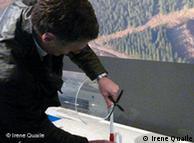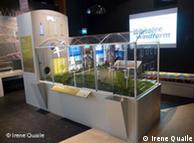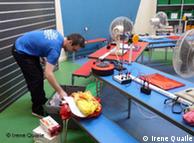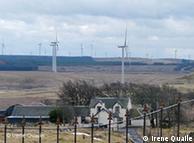ENERGY | 09.08.2010
Build your own turbine
You can see them in the country, along the motorway and even in the sea. Wind turbines are popping up all over Europe.
Outside the Scottish city of Glasgow is one of Europe's biggest onshore wind farms. Built on Eaglesham Moor, Whitelee Windfarm has 140 turbines and generates enough energy to power 180,000 homes. Working in collaboration with the Glasgow Science Center, Scottish Power Renewables decided the turbines could also be used to teach the public about renewable energy.
At the Whitelee Windfarm visitor center, a game show is running in the background. Ten frequently asked questions about wind energy are accompanied by music, video and plenty of flashing lights. Fun and entertainment are high on the agenda here.
 Martin Mathers is the Whitelee Windfarm community relations officer
Martin Mathers is the Whitelee Windfarm community relations officer
Martin Mathers, the community relations officer, knows the best way to get a message across is to make it fun to hear. The game show is just one of the attractions with which Mathers and his colleagues teach interested visitors about the 140 giant wind turbines scattered across Eaglesham moor. The energy-efficient building includes an exhibition hall, a cafe and a classroom - and it is heated using sustainable energy.
People appreciate the opportunity to look at the turbines from the warmth of the cafe, says Mathers.
"As an upland site for a wind farm, it can get pretty cold and draughty up here," he says.
Design your own wind farm
 Visitors can test their mini wind park in this wind tunnel
Visitors can test their mini wind park in this wind tunnel
Inside the exhibition hall, visitors marvel at the size of a nose cone from a turbine, dismantled for people to have a better look. They then turn their attention to a large display case. Inside, there is a model of a hilly landscape with a set of minature wind turbines.
"This is the wind tunnel," Mathers explains. "We have a series of fans, which suck air into the tunnel. You can build your own mini wind farm and test it in the wind tunnel."
This display is part of a competition. Each set of turbines is color-coded.
"There are basically four teams: blue, yellow, green and red. The children can choose which color they want to play with and place their turbines on the landscape. Then we power up the turbines, and the gauges tell us who has designed the best wind farm," says Mathers.
More fun than school?
In addition to the colorful displays, Whitelee has a special classroom equipped with the latest technology to teach children about renewables. David Moody from the Glasgow Science Center sets up fans and miniature turbine components on brightly colored tables. He's preparing a wind energy workshop.
 David Moody sets up for a workshop on turbine efficiency
David Moody sets up for a workshop on turbine efficiency
"The aim is to find out what shape of blade works most efficiently," he says. "They always seem to enjoy this."
The center has space for up to 34 pupils. While one half is experimenting with the equipment in the classroom, the others are on a guided tour of the turbines outside. They travel in a bus powered by the wind.
'You can use the wind again and again'
Christine Balloch is the science coordinator at the local school, Eaglesham Primary. Renewable energy is one of the subjects on the curriculum, so she is delighted that her students can learn about turbines firsthand.
"The opportunity to come up here with the children, so that they can see the wind turbines for themselves and see how beautiful and majestic they are - but also the sheer power that comes with them - is just amazing," she enthuses. "And the children can get their hands dirty. They can experiment and do all sorts of things. It's a really good experience."
The students seem to agree. Ten-year-old Elizabeth says she enjoyed the tour of the turbines.
"It's better for our planet. It's much better than using batteries," says Elizabeth, who also likes to walk with her dog among the turbines on the moor.
Luke is also a pupil who is visitng the center. He has become a fan of renewable energy, thanks to the lessons on the wind farm.
"You can power lots of homes," he says. "I think it's a brilliant idea. It's much better than ordinary electricity, because that produces too much greenhouse gas which can affect the Earth. The wind is renewable. You can use it again and again and again. And it doesn't hurt the planet at all."
Author: Irene Quaile
Editor: Saroja Coelho


No comments:
Post a Comment